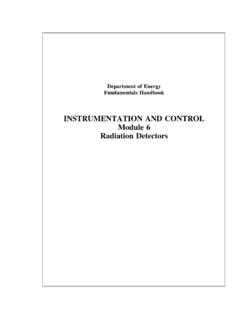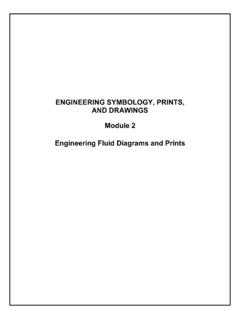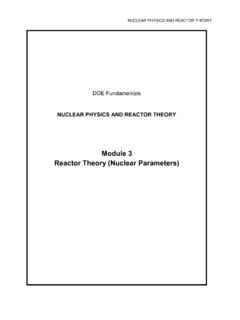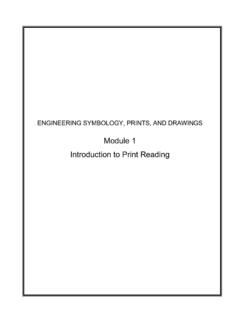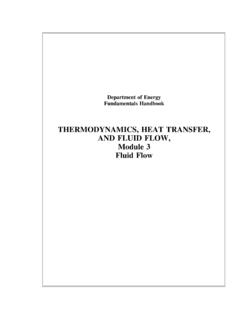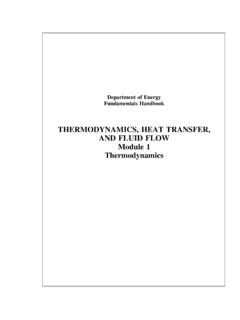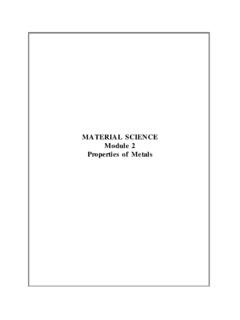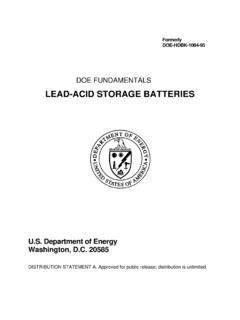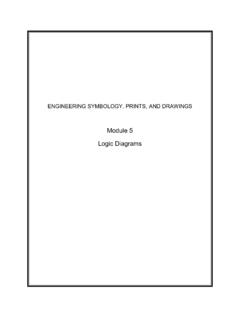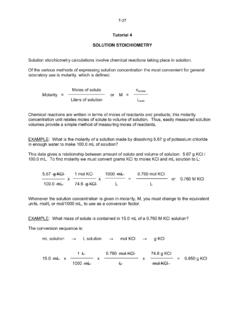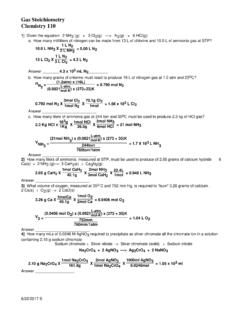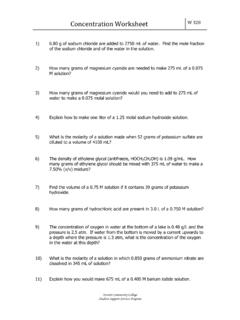Transcription of CHEMISTRY Module 1 Fundamentals of Chemistry
1 Department of EnergyFundamentals HandbookCHEMISTRYM odule 1 Fundamentals of ChemistryFundamentals of ChemistryDOE-HDBK-1015/1-93 TABLE OF CONTENTSTABLE OF CONTENTSLIST OF ivLIST OF viiCHARACTERISTICS OF of Atom s of 11 THE PERIODIC 12 Periodic 12 Classes of the Periodic 16 Group 18 Atomic Structure of 22 CHEMICAL 23 Chemical 23 Ionic 24 Covalent 25 Metallic 27 Van der Waals 27 Organic 30 Rev. 0 Page iCH-01 TABLE OF CONTENTSDOE-HDBK-1015/1-93 Fundamentals of ChemistryTABLE OF CONTENTS (Cont.) 31 Basic Chemical 31 Forming Chemical 32 Combining 34 CHEMICAL 36Le Chatelier s 38 Parts per 39 Chemical 40 Balancing Chemical 45 ACIDS, BASES, SALTS, AND 48pH.
2 48pOH .. 49 Dissociation 53 APPENDIX A BASIC SEPARATION A-1 Isotopic A-1 Separation A-2 Barrier A-6 Circuit iiRev. 0 Fundamentals of ChemistryDOE-HDBK-1015/1-93 TABLE OF CONTENTSTABLE OF CONTENTS (Cont.) Gas Gas 0 Page iiiCH-01 LIST OF FIGURESDOE-HDBK-1015/1-93 Fundamentals of ChemistryLIST OF FIGURESF igure 1 Schematic of a Simple Atom (Helium).. 2 Figure 2 A Mole of Gold Compared to a Mole of 9 Figure 3 Periodic Table of the 15 Figure 4 Regional Schematic of Periodic 16 Figure 5 Electron Shells of 19 Figure 6 Ionic Bond, Sodium 24 Figure 7 Covalent Bond, Methane 25 Figure 8 Formation of the Carbon Dioxide 26 Figure 9 Coordinate Covalent Bond, Chlorate Ion 26 Figure 10 Van der Waals 28 Figure 11 29 Figure 12 29 Figure 13 30 Figure 14 30 Figure 15 30 Figure 16 31 Figure 17 Ion Product Constant for 52 Figure A-1 "R" Stage A-2 Variation of Permeability with the Slope Factor and Change in A-3 Pressures, Temperatures.
3 And Flows in a Typical V-31 A-4 Typical ivRev. 0 Fundamentals of ChemistryDOE-HDBK-1015/1-93 LIST OF TABLESLIST OF TABLEST able 1 Properties of the Atom and its Fundamental 2 Table of 3 Description of the Properties of the First Twenty 12 Table 4 Electrons, Orbital, and Shell Relationships in Atomic 20 Table 5 Ion Product Constant and Neutral pH for Water at Various 51 Table A-1 Converter Stage Size vs. 0 Page vCH-01 REFERENCESDOE-HDBK-1015/1-93 Fundamentals of ChemistryREFERENCESD onald H. Andrews and Richard J. Kokes, Fundamental CHEMISTRY , John Wiley & Sons,Inc., 1963 Compressed Gas Association, Inc., Handbook of Compressed Gases, 2nd Edition,Reinhold Publishing Corporation, A.
4 Day, Jr. and R. C. Johnson, General CHEMISTRY , Prentice Hall, Inc., , Gray, Darensbourg and Darensbourg, Chemical Principles, 4th Edition, TheBenjamin Cummings Publishing Company, Program for Nuclear Plant Personnel, Volume II, CHEMISTRY , Columbia, MD,General Physics Corporation, Library of Congress Card #A 326517, Physics Corporation, Fundamentals of CHEMISTRY , General Physics Corporation, and Sesonske, Nuclear Reactor Engineering, 3rd Edition, Van NostrandReinhold Company, , Accident Prevention Manual for Industrial Operations Engineering andTechnology, Volume 2, 8th Edition, National Safety Council, and Plane, Chemical Principles and Properties, 2nd Edition.
5 McGraw and Hill, , CHEMISTRY for Colleges and Schools, 2nd Edition, Edward Arnold, Ltd., V. Steere and Associates, CRC Handbook of Laboratory Safety, 2nd Edition,CRC Press, Inc., viRev. 0 Fundamentals of ChemistryDOE-HDBK-1015/1-93 OBJECTIVESTERMINAL references,DESCRIBEthe characteristics of an following of atomic molecular components of an atom, their relative sizes, and criterion used to classify an atom following subdivisions of the periodic of the periodic of the periodic of the periodic a periodic table,IDENTIFYthe following of the periodic of the periodic of the periodic characteristics that elements in the same group on the periodic table term 0 Page viiCH-01 OBJECTIVESDOE-HDBK-1015/1-93 Fundamentals of ChemistryTERMINAL an incomplete chemical equation.
6 BALANCEthe equation by the following der Waals physical arrangement and bonding of a polar three basic laws of chemical elements combine to form chemical probability of any two elements combining to form a following Chatelier s following equations that combine elements and/or viiiRev. 0 Fundamentals of ChemistryDOE-HDBK-1015/1-93 OBJECTIVESTERMINAL sufficient information about a solution,CALCULATEthe pH and pOH of following constant of formula for formula for pH of a specified 0 Page ixCH-01 OBJECTIVESDOE-HDBK-1015/1-93 Fundamentals of ChemistryIntentionally Left BlankCH-01 Page xRev. 0 Fundamentals of ChemistryDOE-HDBK-1015/1-93 CHARACTERISTICS OF ATOMSRev.
7 0CH-01 Page 1 CHARACTERISTICS OF ATOMSC hemistry is defined as the systematic investigation of the properties,structure, and behavior of matter and the changes matter undergoes. Thisgeneral definition raises many questions. These questions are answered inthe study of CHEMISTRY . Terms and basic concepts that help in understandingchemistry will be discussed in this the following of atomic molecular weightEO the components of an atom, their relative sizes, the criterion used to classify an atom of MatterThe term states of matter refers to the physical forms in which matter exists: solid, liquid, andgas. Solids are characterized as having both a definite shape and a definite volume.
8 In a solid,the forces that keep the molecules or atoms together are strong. Therefore, a solid does notrequire outside support to maintain its have definite volumes but indefinite shapes and are slightly compressible. Liquids takethe shape of their containers. The forces that keep a liquid's molecules or atoms together areweaker than in the are readily compressible and capable of infinite expansion. They have indefinite shape andindefinite volume. Of the three states, gases have the weakest forces holding their molecules oratoms different states of matter have one thing in common; they can all be broken down intofundamental units called OF ATOMSDOE-HDBK-1015/1-93 Fundamentals of ChemistryCH-01 Rev.
9 0 Page 2 Figure 1 Schematic of a Simple Atom (Helium)The Atom StructureAll matter is composed of atoms, existing individually or in combination with each other. Anatom is an extremely small electrically-neutral particle. It is the smallest unit involved in thechemical change of matter. Atoms can be treated as distinct particles because they behave assuch chemically, but atoms themselves are composed of even smaller subparts. Understandingthese atomic subparticles is important in understanding atom is composed of a positively-charged nucleus orbited by one or more negatively-chargedparticles called electrons. A simplified schematic representation of this arrangement is illustratedin Figure 1.
10 The nucleus is the core of an atom. It has a positive charge because it usuallyconsists of two particles, the neutron and the proton (hydrogen is the exception with only aproton in the nucleus). The neutrons are electrically neutral, and the protons are electricallypositive. A nucleus with one proton has a charge of +1 (or simply 1), and a nucleus with twoprotons has a +2 charge. Together the neutrons and protons give the nucleus its mass, but theproton alone gives the nucleus its positive and protons are relatively massive and are essentially equal in mass. Fundamentals of ChemistryDOE-HDBK-1015/1-93 CHARACTERISTICS OF ATOMSRev. 0CH-01 Page 3 The particles that orbit the nucleus are electrons.
